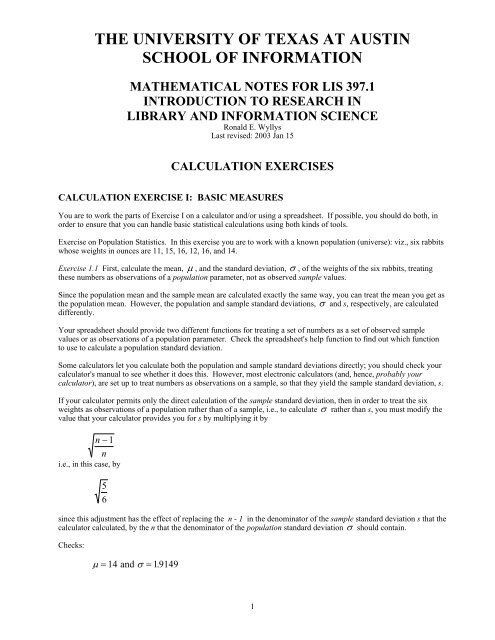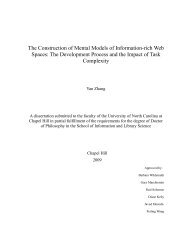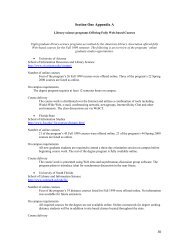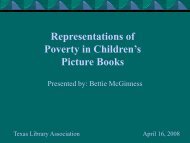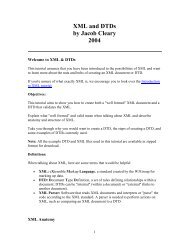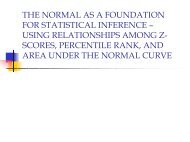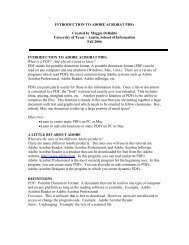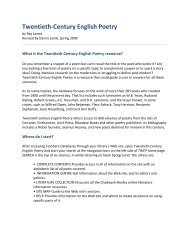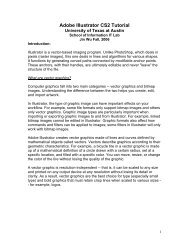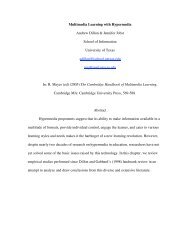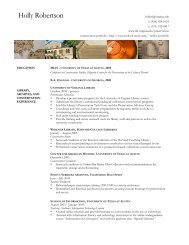CALCULATOR EXERCISES - School of Information - The University ...
CALCULATOR EXERCISES - School of Information - The University ...
CALCULATOR EXERCISES - School of Information - The University ...
You also want an ePaper? Increase the reach of your titles
YUMPU automatically turns print PDFs into web optimized ePapers that Google loves.
THE UNIVERSITY OF TEXAS AT AUSTIN<br />
SCHOOL OF INFORMATION<br />
MATHEMATICAL NOTES FOR LIS 397.1<br />
INTRODUCTION TO RESEARCH IN<br />
LIBRARY AND INFORMATION SCIENCE<br />
Ronald E. Wyllys<br />
Last revised: 2003 Jan 15<br />
CALCULATION <strong>EXERCISES</strong><br />
CALCULATION EXERCISE I: BASIC MEASURES<br />
You are to work the parts <strong>of</strong> Exercise I on a calculator and/or using a spreadsheet. If possible, you should do both, in<br />
order to ensure that you can handle basic statistical calculations using both kinds <strong>of</strong> tools.<br />
Exercise on Population Statistics. In this exercise you are to work with a known population (universe): viz., six rabbits<br />
whose weights in ounces are 11, 15, 16, 12, 16, and 14.<br />
Exercise 1.1 First, calculate the mean, µ , and the standard deviation, σ , <strong>of</strong> the weights <strong>of</strong> the six rabbits, treating<br />
these numbers as observations <strong>of</strong> a population parameter, not as observed sample values.<br />
Since the population mean and the sample mean are calculated exactly the same way, you can treat the mean you get as<br />
the population mean. However, the population and sample standard deviations, σ and s, respectively, are calculated<br />
differently.<br />
Your spreadsheet should provide two different functions for treating a set <strong>of</strong> numbers as a set <strong>of</strong> observed sample<br />
values or as observations <strong>of</strong> a population parameter. Check the spreadsheet's help function to find out which function<br />
to use to calculate a population standard deviation.<br />
Some calculators let you calculate both the population and sample standard deviations directly; you should check your<br />
calculator's manual to see whether it does this. However, most electronic calculators (and, hence, probably your<br />
calculator), are set up to treat numbers as observations on a sample, so that they yield the sample standard deviation, s.<br />
If your calculator permits only the direct calculation <strong>of</strong> the sample standard deviation, then in order to treat the six<br />
weights as observations <strong>of</strong> a population rather than <strong>of</strong> a sample, i.e., to calculate σ rather than s, you must modify the<br />
value that your calculator provides you for s by multiplying it by<br />
n − 1<br />
n<br />
i.e., in this case, by<br />
5<br />
6<br />
since this adjustment has the effect <strong>of</strong> replacing the n - 1 in the denominator <strong>of</strong> the sample standard deviation s that the<br />
calculator calculated, by the n that the denominator <strong>of</strong> the population standard deviation σ should contain.<br />
Checks:<br />
µ = 14 and σ = 19149 .<br />
1
Exercise 1.2 Next, draw five different samples <strong>of</strong> size 2 from this universe; namely, sample A = 11, 16; B = 15, 12; C<br />
= 11, 12; D = 14, 16; and E = 16, 16. Calculate the sample mean and standard deviation for each sample.<br />
Checks:<br />
A: X = 13.5000; s = 3.5355<br />
B: X = 13.5000; s = 2.1213<br />
C: X = 11.5000; s = 0.7071<br />
D: X = 15.0000; s = 1.4142<br />
E: X = 16.0000; s = 0.0000<br />
Exercise 1.3 Now find (a) the mean <strong>of</strong> these sample means, and (b) the mean <strong>of</strong> these sample SDs. How do the results<br />
compare with the population values you found earlier? I.e., how does the mean <strong>of</strong> these five sample means compare<br />
with the population mean? how does the mean <strong>of</strong> these five sample SDs compare with the population SD?<br />
Note, first, the variation among the various sample means and SDs. This example is intended to be instructive with<br />
respect to the range <strong>of</strong> variation possible in sampling, especially with samples <strong>of</strong> very small size.<br />
Note, second, that the mean <strong>of</strong> these sample means is closer to the population mean than any <strong>of</strong> the individual means <strong>of</strong><br />
the samples, and that the mean <strong>of</strong> the sample SDs is closer to the population SD than most <strong>of</strong> the sample SDs. This<br />
illustrates the general principle that the larger the sample, the closer the sample values tend to be to the corresponding<br />
population parameters.<br />
Checks:<br />
(a) Mean <strong>of</strong> the five sample means = 13.9000<br />
(b) Mean <strong>of</strong> the five sample SDs = 1.5556<br />
CALCULATION EXERCISE II: t-TESTS OF HYPOTHESES<br />
You are to work the parts <strong>of</strong> Exercise II on a calculator and/or using a spreadsheet. If possible, you should do both, in<br />
order to ensure that you can handle basic statistical calculations using both kinds <strong>of</strong> tools.<br />
This exercise is intended to give you some practice in testing the kind <strong>of</strong> statistical hypothesis that is concerned with<br />
whether a population mean has a particular value. In reporting your conclusion for each part <strong>of</strong> this exercise, you<br />
should state an appropriate hypothesis and interpret your result fully; i.e., not only should you say whether your<br />
decision is to reject or not to reject the hypothesis but also you should say what your decision about the truth <strong>of</strong> the<br />
hypothesis means in terms <strong>of</strong> the original situation.<br />
Exercise 2.1 You have just graduated from GSLIS and have gone to work in the Catalog Department <strong>of</strong> a large library.<br />
Being the junior pr<strong>of</strong>essional in the Department, you have been assigned, among other things, the duty <strong>of</strong> supervising<br />
the clerks who input cataloging data into the OCLC database. Currently, these clerks work a full 4-hour shift with one<br />
15-minute break in the middle. Full <strong>of</strong> fresh ideas on personnel management from your GSLIS Administration course<br />
and imbued from your Research course with the idea that "sometimes there is a better way," you wonder whether three<br />
10-minute breaks evenly spaced through the 4-hour shift might change the data-input efficiency, as measured by total<br />
numbers <strong>of</strong> cataloging records entered per clerk per shift. You know that the current mean number <strong>of</strong> records entered<br />
per clerk per shift is 127.<br />
You persuade the Head <strong>of</strong> the Catalog Department to let you try out the new break pattern. In the third week <strong>of</strong> the<br />
new pattern, when you feel its novelty has worn <strong>of</strong>f enough, you obtain the random sample given below <strong>of</strong> total<br />
numbers <strong>of</strong> records entered in one shift by different clerks. You use these data to perform a t-test <strong>of</strong> the hypothesis that<br />
the mean data-entry rate is still 127 cataloging records per clerk per shift. If you use a 95-percent confidence interval<br />
or--equivalently--work at a 5-percent level <strong>of</strong> significance, what is your conclusion?<br />
Checks:<br />
104 191 210 169 96 209<br />
199 189 130 204 101 217<br />
X = 168. 2500; s = 46. 9877; s X<br />
= 135642 .<br />
<strong>The</strong> 95% confidence interval for the population mean is (138.40, 198.10)<br />
2
Exercise 2.2 A little less than a year ago, when your library first started <strong>of</strong>fering a database-searching service to your<br />
patrons, you found that the mean cost to your patrons <strong>of</strong> a database search was $34.56. Now that it is close to the time<br />
for a decision on whether to renew the contract with the database service, you wonder whether your staff have grown<br />
more skilled in assisting patrons with searches and whether patrons (at least those who use the service repeatedly) have<br />
grown more sophisticated in formulating their search questions. If either or both <strong>of</strong> these possibilities has occurred,<br />
there ought to be a noticeable decrease in the mean cost <strong>of</strong> a search.<br />
To investigate, you check the costs <strong>of</strong> the most recent 40 searches (which you judge to constitute an adequately random<br />
sample), and you obtain the data below. You use these data to perform a t-test <strong>of</strong> the hypothesis that the mean cost is<br />
still $34.56. If you use a 95-percent confidence interval or--equivalently--work at a 5-percent level <strong>of</strong> significance,<br />
what is your conclusion?<br />
Checks:<br />
20.47 39.12 37.24 37.43 27.19<br />
14.23 44.80 34.08 38.30 56.28<br />
40.34 38.34 23.14 5.98 49.39<br />
17.72 20.02 50.22 48.83 29.80<br />
28.28 31.96 27.48 41.67 25.31<br />
25.93 43.25 37.62 23.97 28.00<br />
50.25 41.81 41.46 34.57 31.01<br />
15.24 43.91 25.90 32.71 28.97<br />
X = 33. 3055; s = 111951 . ; s X<br />
= 17701 .<br />
<strong>The</strong> 95% confidence interval for the population mean is (29.73, 36.88)<br />
CALCULATION EXERCISE III: ANOVA AND t-TESTS<br />
This exercise is intended to give you some practice in carrying out the analysis-<strong>of</strong>-variance (ANOVA) procedure,<br />
together with further practice in using the t-test procedure. Both procedures can be carried by using a calculator and/or<br />
a spreadsheet program and following the arithmetic steps explained in LIS 397.1. However, since even modest<br />
statistical program packages these days contain a module for doing ANOVA, I recommend doing the parts <strong>of</strong> Exercise<br />
III using such a package.<br />
Exercise 3.1 <strong>The</strong> following table contains a randomly selected set <strong>of</strong> actual total GRE scores <strong>of</strong> GSLIS students. A<br />
naive examination reveals that the men have a higher mean score than the women, and thus seems to suggest that the<br />
men are smarter than the women. But what does a careful examination reveal?<br />
One way <strong>of</strong> doing a careful examination is apply the ANOVA procedure to these scores. For Exercise 3.1 please use a<br />
calculator to carry out an ANOVA test on the scores. Going through the manual calculation procedure once will help<br />
you understand better the ANOVA tables produced by computer programs that do ANOVA.<br />
Women 1030 1310 1050 1140 1300 1310 720 1140 1020 1160<br />
Men 1210 1230 1570 1090 1230 1010 1300 860 1240 1180<br />
To help you check your arithmetic, here are two entries in the ANOVA table:<br />
T 631,300<br />
B<br />
SS DF MS F<br />
W 33,551.11<br />
State an appropriate hypothesis, and interpret your result fully; i.e., you are not only to say whether your decision is to<br />
reject or not to reject the null hypothesis but also to say what the ANOVA result means in terms <strong>of</strong> the original<br />
exercise.<br />
Exercise 3.2 With the data given in Exercise 3.1, carry out a test <strong>of</strong> the appropriate hypothesis by means <strong>of</strong> the t-test<br />
for independent samples, using the pooled-estimate-<strong>of</strong>-variance procedure. State your hypothesis, and interpret your<br />
3
esult fully. (If you use Micros<strong>of</strong>t Excel to work this exercise, you should note that the pooled-estimate-<strong>of</strong>-variance<br />
procedure is invoked in Excel by using the procedure called "t-Test: Two-Sample Assuming Unequal Variances".)<br />
Checks:<br />
t obs = -0.90337<br />
P(T
Exercise 4.2.2 Also use this sample to test the null hypothesis<br />
Check:<br />
: Detective stories circulate twice as frequently on Saturdays and Sundays as on other days <strong>of</strong> the week<br />
H 02<br />
2<br />
χ obs<br />
= 2.07<br />
Exercise 4.3 Female vs. Male Library Budgets. <strong>The</strong> following data are taken from Table 8 <strong>of</strong> the following article:<br />
Blankenship, W. C. How Many Men? How Many Women? College and Research Libraries. 1967 January; 28:41-8.<br />
PER CENT OF NUMBER OF NUMBER OF<br />
INSTITUTIONAL MALE HEAD FEMALE HEAD<br />
BUDGET LIBRARIANS LIBRARIANS<br />
under 2% 9 6<br />
2-4% 78 60<br />
4-6% 92 109<br />
over 6% 19 18<br />
<strong>The</strong>se data concern the numbers <strong>of</strong> men and women directors <strong>of</strong> academic libraries, in a random sample <strong>of</strong> such<br />
directors, who reported obtaining, for their libraries, budgets expressed as various percentages <strong>of</strong> the overall budgets <strong>of</strong><br />
their colleges or universities. Blankenship says that from these data "It would appear that the ladies are slightly better<br />
at getting the money than are the men."<br />
Do Blankenship's data support his comment? Apply the chi-square test <strong>of</strong> association to his data. State an appropriate<br />
null hypothesis, work out the observed chi-square score to three decimal places, and interpret the result.<br />
Check:<br />
2<br />
χ obs<br />
= 4.349<br />
CALCULATION EXERCISE V: REGRESSION<br />
You are to work the parts <strong>of</strong> Exercise V on a calculator and/or using a spreadsheet. If possible, you should do both, in<br />
order to ensure that you can handle basic statistical calculations using both kinds <strong>of</strong> tools.<br />
This exercise is intended to illustrate some <strong>of</strong> the ideas <strong>of</strong> regression analysis. To provide a numerical illustration, we<br />
use the example <strong>of</strong> an actual study that compared the heights <strong>of</strong> brothers and sisters to see whether tall sisters tended to<br />
have tall brothers, or equally well put, whether short brothers tended to have short sisters. In this context, <strong>of</strong> course, a<br />
"tall" sister (brother) is one who is tall compared to the average height for women (men), and similarly for "short"<br />
people.<br />
Here are the data, with heights in inches:<br />
SIBLING PAIR NUMBER<br />
1 2 3 4 5 6 7 8 9 10 11<br />
Brother 71 68 66 67 70 71 70 73 72 65 66<br />
Sister 69 64 65 63 65 62 65 64 66 59 62<br />
Your first step is to plot these observed pairs <strong>of</strong> points on a page <strong>of</strong> graph paper or cross-section paper (paper ruled both<br />
horizontally and vertically in increments <strong>of</strong>, for example, 1/5 or 1/4 inch). Use a scale that not only will be convenient<br />
but also will spread the points over an area <strong>of</strong> at least 5 or 6 inches both horizontally and vertically. For the sake <strong>of</strong><br />
uniformity, it is necessary to make an arbitrary choice <strong>of</strong> axes and <strong>of</strong> independent and dependent variables: the sisters'<br />
heights are to be plotted on the horizontal axis, the X-axis, and the brothers' heights on the vertical axis, the Y-axis.<br />
Following the usual (though not mandatory) arrangement, this means that we shall consider the X-axis variable, sister's<br />
height, as the independent variable and, hence, brother's height as the dependent variable.<br />
When you have finished plotting the eleven points, try sketching (i.e., drawing free-hand) a straight line that seems to<br />
you to represent the overall tendency <strong>of</strong> siblings to have comparable heights (with respect to the mean height <strong>of</strong> each<br />
sibling's sex). In other words, sketch a straight line that seems to you to represent the overall trend <strong>of</strong> the plotted<br />
points. You may find it helpful to use a transparent ruler in drawing this line. (Note: You can do the plotting <strong>of</strong> the<br />
5
points via a spreadsheet, but I want you to do, by hand and eye judgment alone (with the aid <strong>of</strong> a rulef), the drawing <strong>of</strong><br />
a straight line through the points after you have printed out the plotted points.)<br />
Next, either (a) by employing computational formulas from the LIS 397.1 Website Mathematical Note on "Using Regression<br />
to Estimate and Predict," or (b) by using formulas from your text, or (c) by means <strong>of</strong> the regression function in<br />
your calculator or spreadsheet, you are to calculate the regression coefficients: B 0 , the intercept coefficient; and B 1 , the<br />
slope coefficient. Write out the regression equation, putting the numerical values you find into the basic equation<br />
!<br />
Y = B + B X<br />
0 1<br />
Pick any two values for X that are within the range <strong>of</strong> the observed values <strong>of</strong> sisters' heights, preferably two values that<br />
are well separated (e.g., 62 and 69 inches). Calculate the predicted values <strong>of</strong> Y that correspond to the X values you<br />
chose, and plot these predicted values on your chart. <strong>The</strong>y are two points on the regression line, and as such, they are<br />
sufficient to define this line. With a ruler, draw the straight line that passes through these two points. Compare this,<br />
the regression line, with the original sample points and with the line you "fitted" to them earlier by eye judgment alone.<br />
You should also examine the sample correlation coefficient. Think about the following questions, and briefly note your<br />
answers: (1) Is this coefficient a Pearson product-moment correlation coefficient? (2) On the basis <strong>of</strong> the observed<br />
sample correlation coefficient, can you reject the null hypothesis that the population correlation coefficient is zero? (3)<br />
Why might you be forced to accept this null hypothesis in this case, despite the fact that it seems intuitively clear that<br />
sibling heights do have a tendency to be similar? (4) What might a larger sample reveal with respect to this null<br />
hypothesis?<br />
Check:<br />
Y" = 3118182 . + 0.<br />
59092 X<br />
6


